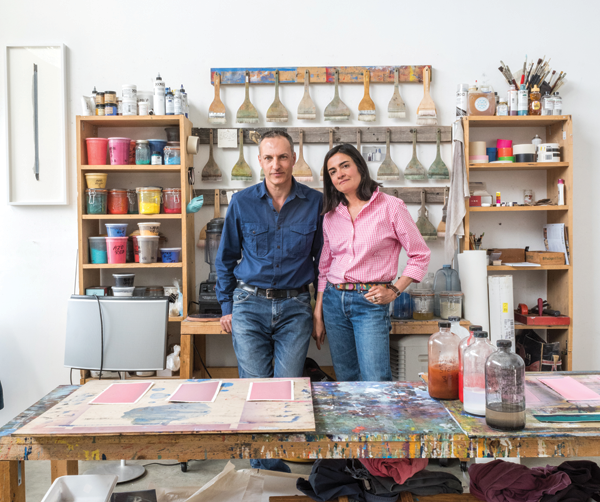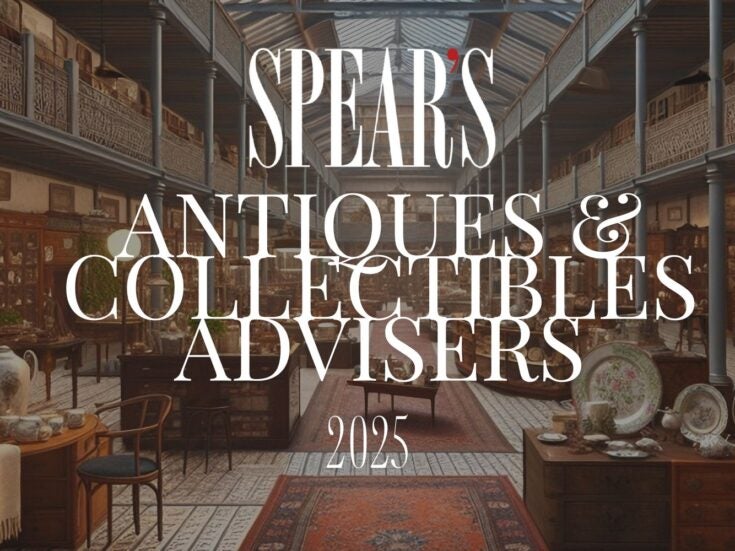

America’s premier fine art lithographer is losing his temper: ‘I thought you were here to talk about my work, not Donald Judd’s.’ This isn’t his first time at this conversational rodeo. And it must be a bore. But it’s difficult to talk about anything in Marfa without first addressing the man who turned a tiny Texas town into the world’s most remote, unlikely art enclave.
If Judd hadn’t set up shop here in the 1970s, then Robert Arber — who, with his artist wife Valerie, co-runs the fine art printing press Arber & Sons from their home in an old movie theatre in the middle of town — wouldn’t be here either. Judd invited Arber to head south to be his sole, specialist printer in 1976, and he’s still here, in the middle of nowhere, long after Judd’s death in 1994. For decades, Judd’s Minimalist tractor beam has pulled aesthetes into the desert, and today it’s stronger than ever.
Marfa is the town that Judd built, although that’s something of an oxymoron. ‘He was adamant about not breaking new ground,’ says artist Maryam Amiryani, who left a job at the Museum of Modern Art in New York ten years ago to live here, in a classic adobe house, with husband and fellow artist Nick Terry. ‘He wouldn’t build something on a site where a structure had not been before.’
Key to this philosophy, and Marfa’s fortunes, was Judd’s reappropriation of a group of vast abandoned artillery sheds (some still with German text on the walls from their use as a PoW camp), transforming them into meticulous exhibition spaces for his own and other artists’ work, creating the sprawling, stunning Chinati Foundation in the process.

One wonders how Judd would feel about Marfa today — a town that’s been turned into a nonstop Instagram circus by Vanity Fair, Condé Nast Traveler et al, as well as the annual music festival at the El Cosmico campsite with its kitschy-cool refurbished trailers, the Garza Marfa interior design store and Elmgreen and Dragset’s permanent Prada Marfa installation out on the side of the desert highway. (It’s a lifesize replica of a Prada store, complete with clothes.) If Marfa hasn’t quite sold out, it’s certainly sold: along with becoming a byword for leftfield style, with pop-up installations in its old abandoned ice plant, groovy food trucks, hidden coffee shops and Padres — a bar and dancehall in an old funeral parlour — Marfa has become expensive. Which is becoming a serious problem.
Marfa was established as a freight stop for the railroad back in 1883, with 900 residents by the turn of the century. Population peaked around 5,000 before the army left in the 1940s, and today it’s just over 2,000. Apart from Judd’s art community, the biggest employers remain the local ranches and Border Patrol (Marfa is 60 miles from Mexico). Infrastructure is delicate, and can’t quite cope with the unforeseen Hackney/Brooklyn effect of the town becoming a magnet for artists and the fashion arrivistes who are hot on their heels. This is prime second-home territory for urban tastemakers, and when Presidio County reappraised its properties in 2014, the county tax base doubled from $563 million to $1.14 billion. In a heartbeat, property prices — both residential and commercial — rocketed three to six times. There’s a fancy new hotel on the way, but a critical housing shortage.
And yet, while you may not be able to pick up an old movie theatre to turn into a live/work studio for a few dollars these days, inflation here is relative: $200,000 will still get you a two-bedroom house, which is a bargain if you’re selling up in Brooklyn, but less so if you’re a born and bred local. Prices have risen, but the fundamentals haven’t changed. As John Waters spelled out on his 2003 Visit Marfa artwork, styled as a coming-attraction carnival poster and describing the town as ‘the Jonestown of Minimalism!’: ‘IT’S A L-O-O-O-O-N-G DRIVE!’
For all the infinite inspirational beauty of the landscape, and the low-rise all-American architecture that bounces the desert light around its largely unpopulated streets, Marfa can be a harsh place to live. You have to embrace a new concept of community, and deal with the realities of the desert. ‘Things open and close when they want to here,’ says Jenny Moore, executive director of the Chinati Foundation, who has the privilege of living on-site, amid the iconic, priceless Judds. ‘Things are… fluid. Sometimes you can’t buy a coffee or a sandwich. But this is a place apart, and a place dedicated to art that has impact and emotion. At the same time, we overlap with the local Mexican-American population and the ranching community, and while everyone wants to come and buy an adobe house and we have design tours for tourists, teachers have a hard time affording a place to live.’

As well as working with her team to shepherd visitors around the 240 acres of the foundation, Moore has to make sure her young daughter is savvy about desert life — it may look like one boundless cinematic playground, but there can be scorpions lurking in between the vast Judd concrete cubes that line the perimeter of the estate. Right now, Moore is working with Robert Irwin on a major installation — the largest to land at Chinati since the foundation gave over substantial space for key Dan Flavin pieces. It’s all more grist to the Instagram mill.
With all the travelogues and social-media eye candy, it’s easy to lose sight of Marfa as the serious hub for creation of art that it actually is. Robert Arber has every right to tire of endless questions about his old boss; he collaborates with Bruce Nauman and Richard Prince and produces beautiful, meticulously boxed editions of prints of work by visiting Chinati Foundation artists-in-residence under the umbrella of his 30x30cm Project. And when Maryam Amiryani and Nick Terry bought their adobe house, right after they re-created Judd-design shelves in their library, they built a large painting studio in their yard. They came here to create.
‘I think our story is typical,’ says Amiryani. ‘A lot of artists feel beaten down by the metropolis and want lower overheads and to be able to focus on their work.’ While Terry works on his paintings in one half of the building, she is finishing a series for a collector in China, based on a carpet that her great-grandmother owned. ‘I was fascinated by it when I walked up and down the stairs, looking down at it. It has great resonance in my family.’

While Arber might be seen as a facilitator rather than artist, his printing process represents a kind of ongoing conceptual or performance piece in itself — which somehow fits the industrial nature of the town. His stone lithography might be seen as a kind of primal parallel to the endless selfies shot by the drivers who pull up at Prada Marfa every five minutes during daylight hours: the artists he works with draw directly on the century-old stone at this studio (‘technically it’s a stone rarer than diamonds,’ he points out, ‘it’s so rarely quarried’). Once the prints are made, he smooths the stone, eliminating the artist’s marks for ever. It’s unique and tactile. As he says: ‘You have to have a physical relationship with the artist, they can’t just bring you something and say, “Here.” And once the edition is done, it’s gone.’
The dialogue between New York, other major cultural cities in the US and Marfa has long been a part of the story of this Texas town. Judd himself was based between Manhattan and Marfa — his old home in SoHo is one of the greatest open houses in the world, complete with a version of the same iconic island bed, sans headboard, that sits in his old studio and home, the Block, in Marfa. As much as anything, Judd created a style. He hated the term ‘Minimalist’, and he would probably have hated how his aesthetic has been assimilated and resold as a style by everyone from Jil Sander to Muji too. But it looks good. Less is more, as long as what’s left is functional and beautiful. It’s what powers the Judd tractor beam.
The ascetic shadow of Judd is cast sharp and long across everything in Marfa and probably always will be. But the town is changing, for better or worse. ‘What’s happening, in my view,’ says Robert Arber, ‘is that people are coming who don’t appreciate Judd’s aesthetic, and they feel they are as good an artist as he was. If you’re living in a studio in Brooklyn, that doesn’t really matter. But this is Juddsville.’






